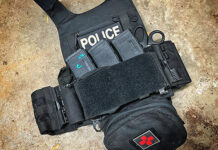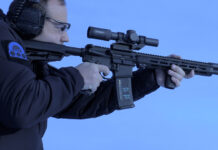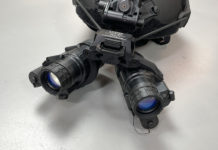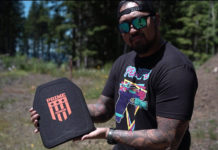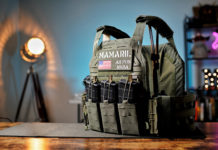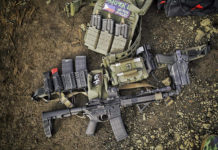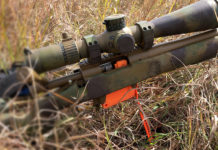The ultimate general-purpose barrel
Faxon Firearms has positioned itself as a no-nonsense, practical firearms company that offers quality components at reasonable prices. My first introduction to Faxon Firearms was a few years ago when they launched the ARAK-21; an AK/AR hybrid upper system that ultimately was not my cup of tea, but served as an example of a company that tries to push innovation and new concepts to a market filled with same old, same old.
I stopped by the Faxon booth at SHOT Show 2016, and was intrigued to see that they had quietly expanded to rails, muzzle devices, and a few new barrel options as well. Looking a little closer at the barrels, I was impressed with their prices, initially, but when I received one of their new GUNNER barrels for review, I finally had an opportunity to see what they were all about beyond the attractive price point.
The GUNNER Barrel
Advertised as the "pinnacle of performance, weight, balance, and value, " I was as usual skeptical of what the barrel could actually do. So, what is a GUNNER barrel? Faxon’s barrels are 4150 Mil-Spec steel or standard 416R stainless. Their barrels are all fabricated in-house in Cincinnati, OH, and are button rifled, stress-relieved, air gauge tested, MPI inspected, and with an 11° target crown. The 14.5" GUNNER barrel I received came with a mid-length gas system, and was QPQ Nitride finished, inside and out.
What sets the GUNNER barrel apart from others is that it is a hybrid between a Government and Pencil barrel profile. From the M4 barrel extension to gas block, the barrel follows standard Government Profile contours, however from the .625 gas block journal to muzzle, it adopts a pencil profile. This makes for a svelte profile, and also enables the barrel itself to weigh in at a scant 1.2 lbs.
I talked to Nathan Schueth, Director of Sales and Marketing, and asked a few questions about the barrel to get a greater understanding of why the GUNNER barrel was positioned as a viable product to buy.
Chris Tran: Nathan, can you describe to our readers the concept of design behind the 14.5" GUNNER barrel? What did Faxon want to achieve with a blended barrel design?
Nathan Schueth: The GUNNER series was developed to meet the market and performance need for a barrel that was truly balanced. Driven by our experience with pencil barrels, we combined it with the well-established "Gov’t" profile to create a barrel that was field, competition, and defense-ready balancing versatility with weight. We wanted and believe we produce a fantastic general-purpose barrel that maintains groupings through hard use while keeping weight to a minimum and perhaps most importantly, biasing it towards the rear to balance the weapon better.
CT: For newer shooters, can you please describe "barrel whip, " and how does the GUNNER profile address this issue that is purportedly seen in other pencil barrels?
NS: Barrel whip refers to the physical deflection of the barrel as it contains the stresses of the detonation of the propellant and acceleration of the projectile down the barrel. It is affected by a variety of factors including barrel profile, the propellant charge, free/non-free floating, etc. The primary "whip" that most people see in slow motion happens after the projectile leaves the barrel so its effect on shooting a single round is minimal – but still important. The GUNNER series addresses this by maintaining a medium tapered profile behind the gas block to best mitigate the whip itself. More material = more rigidity. From the gas block forward, where the pressure has dropped significantly and the deflection of the barrel at that point is reduced, we move towards a much thinner profile which keeps velocity while cutting down on weight.
CT: What is Faxon’s performance expectations from the GUNNER series of barrels?
NS: That the customer loves it or we make it right.
CT: A big part of selecting the right components for an AR build is to understand the end-user’s application. Lightweight builds have been all the rage for the past couple of years. That being said, end users must understand that there are certain compromises that must be made when it comes to component selection. For a lighter weight profile barrel, it is generally understood that gaining the advantage of weight savings in a lightweight barrel can result in a barrel that heats up more rapidly than a standard profile, and accuracy at range and over sustained periods of fire can be compromised. GUNNER profile barrels are obviously not for the long-distance game. What would you want your end-users to know about the GUNNER series, and what application do you see the GUNNER series of barrels best used for?
NS: Unfortunately, it’s a long-perpetuated myth that accuracy is "compromised" in thin barrels. This has perpetuated as the first thin barrels were not stress-relieved, which caused their POI to shift as the barrel heated up. With modern barrel manufacturing methods across any style of rifling, the barrels are capable of maintaining their POI, even as they get hot. Yes, groups open up, but the opening is typically no more than double the base accuracy of a cold-bore. So, if a pencil barrel is 1 MOA, it will be roughly 2 MOA when piping hot – at least for our barrels. This is well below military acceptable accuracy standards.
The GUNNER series is a balanced profile. It’s designed for those who likewise balance versatility and usability – which is 99% of shooters out there using a general-purpose carbine. We use in-house for all our staff’s competition rifles and they have multiple match wins under their belts. Likewise, it’s on our home defense carbines (when we don’t have an ARAK nearby).
CT: What should end users know about Faxon Firearms? When purchasing your barrels, are there specific warranties or guaranteed performance standards that can be expected?
NS: Unlike many who buy and resell, Faxon is an original manufacturer. We make our products and only when we cannot, we make sure they are sourced from similar quality shops within the USA – no exceptions. We have expertise in machining across generations and have high-precision parts on Mars through NASA, in bombs for the Air Force, and multiple other industries including cars, boats, and deep-sea exploration.
We believe in standing behind the product 100%. That each product meets our rigorous AS:9100 and other quality certifications and that we would shoot anything we offer ourselves in our own guns. We don’t believe in accuracy guarantees, as they are typically fraught with terms and conditions and are highly subjective on the individual build, shooter, and other chosen parts. Instead, we ensure the product meets the customers’ expectations are always there to support customers with the best service in the industry. If a product does not meet a customer’s standards, we make it right – period.
Building in Context
For average guys like me, I don’t really geek out on microscopic specs, and I’m not like some of my peers that are out tuning and building extreme precision rifles. For a lightweight build, weight is obviously important, as is reliability and consistency. I want a lightweight build to function flawlessly, but balance weight-savings with a stable shooting platform that can handle various loads with repeatable performance – a versatile fighting rifle that won’t necessarily be used as a DMR rifle or a precision build, but something I can carry comfortably, shoot efficiently, and get combat effective hits from close to moderate distances. There is no one-size-fits all build, so choosing a barrel for the build must be put into context of what the user wants the rifle to do.
Going into building out my rifle for the GUNNER barrel, I decided I wanted a reliable, comfortable, fast, and combat-accurate rifle.
Performance
Once built, I had a couple of exercises I wanted to run the barrel through.
I capped the barrel with a pinned and welded Advanced Armament Corporation Blackout 51T flash hider that I had lying around, and I was off to the races.
At 50 yards, I zeroed with cheap DRS once-fired remanufactured ammunition that I can pick up for about $.31/round, which fits my budget for general consumption ammo in the 55gr FMJBT realm. Easy sub-MOA groups with cheap ammo, so for a kick-around rifle that will eat the cheap stuff and perform well, I was happy.
Additionally, after a 5-round group, 2 30-round mag dumps, and another 5-round group, deviation was absolutely negligible.
The only recordable variance worth noting was a slight POI with the AAC 556SD suppressor; impact shifted about 1" down and to the right. Not too shabby.
 Photo Credit: Chris Tran
Photo Credit: Chris Tran
Now on to 100 yards. With the cheap DRS ammo (55gr FMJBT), I was hovering around 3" 5 shot groups. I’m not the best shooter in the world, but from a sandbag and prone, I usually can shoot better than that. If the group and distance was doubled – 200 yards and opening up to 6" groups…that’s not the best in the world. Granted, it’s a 14.5" barrel, and a hybrid barrel at that, so for a lightweight barrel that can achieve combat-accurate hits, the barrel was still within the realm of acceptability.
I purchased some better quality ammo: Black Hills .223 reman 55gr, Black Hills reman 69gr MatchKing HP, Hornaday .223 Superformance 75gr BTHP, and some Federal Premium .223 77gr BTHP, and went for another go.
Again, from 100 yards prone with a sandbag and a Vortex Viper PST 1-4×24, I was down to about 1.5" – 1.75" 5 round group with the Federal Premium 77gr BTHP. Much better. I posted a quick cellphone shot of that up on Instagram, quoted it as more than acceptable, and signed off. Here’s where my bias came in – I figured that for a no-frills, lightweight, 14.5" barrel that costs under $200, with all of those factors taken in totality, the GUNNER barrel was more than adequate for users looking to build a fast and lightweight rifle that could achieve combat accurate shot for close to moderate distances. I saw no problem with it at all.
 Photo Credit: Chris Tran
Photo Credit: Chris Tran
To my surprise, I was contacted less than 48 hours later by Nathan, who said the following:
"A pleasure to reach out to you on the 14.5" gunner. We saw the accuracy results posted on Instagram and were disappointed to see the results. Simply put, we hold ourselves to a higher standard.
What we are curious to review, if you are willing, is getting that barrel/weapon back to Faxon for analysis.
We’d love to cover the cost of getting that back to Faxon and likewise, we have the latest and greatest with the slim brake that we welded available to you as well. "
Well color me a little mollified.
I responded to Nathan, and asked that he give me another go. I thought it more appropriate to question the ability of the shooter, rather than the inherent mechanical accuracy of the barrel itself. I was on 3 hours of sleep and rushing when I shot the groups with different ammo, and it was more likely that it was me, not the barrel.
A few days later, with 6 hours of sleep under my belt instead of 3, I went out again and with the exception of one obvious flyer in the group, my rounds printed pretty well using the Black Hills 69gr MatchKing HP over a few groups. See below.
 Photo Credit: Chris Tran
Photo Credit: Chris Tran
Nathan was much relieved, and indicated that this is much more in line with what they require from their barrels…and more akin to what they were used to seeing in their own tests.
Conclusion
In my assessment, I think that Faxon Firearms proved a couple of things. First, the folks at Faxon say what they mean and mean what they say when it comes to customer service and making sure their customers are pleased. I was impressed that they were willing to be open to inspect their own product for deficiencies rather than simply blame the shooter (as was obviously the case).
Second, these barrels are great and fall in line with exactly what I look for in a product; quality gear from quality people with a balance of durability, performance, and cost effectiveness.
High points for the GUNNER barrel:
All in all, I have nothing bad to say about the Faxon Firearms GUNNER barrel, and there may be more of these for me in the very, very near future. Buy these with confidence, just know your application.
 Photo Credit: Chris Tran
Photo Credit: Chris Tran
Want to know more about Faxon Firearms?
Check them out at faxonfirearms.com, Facebook, and Instagram.
Also, want to learn more about the AR/AK hybrid ARAK-21?
Or the Faxon Firearms Ultra Light Gunner Bolt Carrier Group?
Check out Chris Tran on Facebook and Instagram.
* The views and opinions expressed on this web site are solely those of the original authors and contributors. These views and opinions do not necessarily represent those of Guns & Tactics Magazine,
the administrative staff, and/or any/all contributors to this site.
Want more posts like this one? Subscribe to Guns & Tactics Magazine to receive email updates and special offers direct to your inbox!



